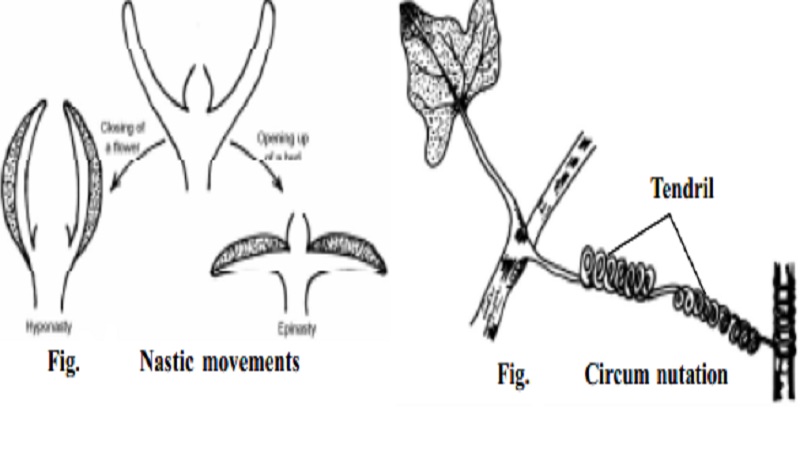Chapter: 11 th 12th std standard Bio Botany plant tree Biology Higher secondary school College Notes
Plant Movements : Movements of locomotion and curvature

Plant Movements
Plants are sedantary living things generally lacking the power of
locomotion. But they possess the property of irritability i.e. the ability to
respond to an external or internal stimulus. This causes some kind of movement
in plants, which is generally a very slow movement and often escapes notice by
the human eye. But these movements can be actually demonstrated by a technique
called time - lapse motion picture photography
or by simply observing the plant at intervals
of several hours and noting the changes in positions of the plant organs. The
movements showed by plants can be classified broadly as (1) Hygroscopic-due to loss or gain of
water and (2) Vital-due to
irritability of the cytoplasm.
The vital
movements may be further subdivided as follows.
I. Movements of Locomotion
These are generally very fast movements which
may be (A) autonomic or Spontaneous and (B) induced or Paratonic. These
movements are very common among lower plants and mostly exhibited by unicellular
organisms. These movements are relatively faster and more pronounced.
(A)
Autonomic Movements : The spontaneous
locomotory movements may be
(i)
Ciliary : due to beating of cilia as in Paramecium.
(ii)
Amoeboid : by the formation of pseudopodia as in
Amoeba.
(iii)
Cyclosis : due to streaming of cytoplasm.
(iv)
Gliding : as seen in Hydra.
(B)
Paratonic movements
The induced locomotory movements are also called tactic movements
induced by external stimuli. Based on the nature of stimuli, these may be of
three types :
(i)
Phototatic movement :
Seen in zoospores and gametes which are provided with a light sensitive
eyespot which is attracted by low light intensities.
(ii) Thermotactic movement :
Movement in response to heat stimulus is seen in certain motile algae
like Chlamydomonas which moves from a
colder to a warmer place.
(iii)
Chemotactic movement :
In bryophytes and pteridophytes, the swimming
antherozoids are attracted towards the archegonium by chemical stimuli such as
organic substances like sugar, malic acid and so on.
(iii)
Movements of curvature
These movements are generally exhibited by
higher plants which remain anchored in one place. These can change or move the
position of their organs by means of curvature. These types of movements may be
further classified as (A) Movements of growth and (B) Movements of Variation.
(A) Movements of growth :
There is a change in the position of the organ either due to increase in
number of cells or enlargement of cells or both. These movements can be
Spontaneous or Autonomic and Induced or Paratonic.
(ii) Spontaneous growth movements :
These
include the (1) Nastic and the (2) Nutational movements
(1) Nastic Movements
These
movements are generally observed in leaves, flowers, petals and bud scales. In
these structures at
some stage of development, growth in one surface
is more than the growth on the other surface. There may be two types of such
movements :
Epinasty : If the upper or
inner surface has more growth, the movement is called epinasty. An
example for epinasty is the
opening up of a flower and the drooping of a bud.
Hyponasty : This
indicates rapid growth on the abaxial or lower side of an organ. An example for this is the unfolding of a fern frond and
closing of a flower.
(2) Nutational
Movement
This
is an irregular movement shown by growing tips as they elongate. In tendrils
and runners, there is a spiral type of growth of the stem apex called circum
nutation. Ordinarily, nutational movements occur due to alternate change in the
opposite sides of the apex. These movements are very slow and cannot be clearly
seen.
(ii) Paratonic
growth movements
These are
the induced movements of growth caused by external stimuli such as gravity,
light, water or contact. The movements show a directional relation to the
stimulus. The stimuli are effective in causing growth movements only when they
are unidirectional. Such movements are generally known as tropic movements and
the phenomenon is referred to as tropism.
Based on the nature of stimulus, tropisms may be of various types.
(A)
Geotropism
(B)
Phototropism
(C)
Hydrotropism
(D)
Chemotropism
(E)
Thigmotropism
Related Topics